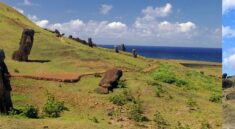The “Cañón de Huasteca” refers to a stunning natural feature located in the Huasteca region of Mexico. This region is known for its rugged landscapes, deep canyons, lush vegetation, and pristine rivers.
The Cañón de Huasteca is celebrated for its breathtaking natural beauty. It features towering cliffs, deep canyons, crystal-clear rivers, waterfalls, and dense forests. The scenery is particularly striking, with lush vegetation contrasting against the rugged terrain.
In addition to its natural wonders, the Huasteca region is known for its indigenous cultures and traditions. Visitors may have the opportunity to learn about the customs and way of life of the local indigenous communities.
How to get there
To get to the Cañón de Huasteca in the Huasteca region of Mexico, you’ll typically need to travel to the state of Nuevo León, which is where the canyon is primarily located. The exact route and access points to the canyon may vary, but here are general guidelines on how to get to the region:
By Air: The nearest major airport to the Huasteca region is Monterrey International Airport (IATA: MTY), located in Monterrey, the capital of Nuevo León. From the airport, you can proceed to the Huasteca region by road.
By Road:
- From Monterrey: If you arrive in Monterrey, you can rent a car or take a bus to reach the Huasteca region. The drive from Monterrey to the Huasteca area can take a few hours, depending on your specific destination within the region.
- By Bus: Several bus companies operate routes to cities and towns in the Huasteca region, including Ciudad Valles, which is a common gateway to the canyons. You can take a bus from Monterrey or other major cities in Mexico to Ciudad Valles and then arrange local transportation to your desired destinations within the Huasteca region.
- Local Transportation: Once you arrive in the Huasteca region, you may need to use local transportation, including taxis or guided tours, to access specific canyons, trails, and natural attractions like the Cañón de Huasteca.
- Guided Tours: Many travelers opt to join guided tours that include transportation to the Huasteca region’s natural wonders, including the Cañón de Huasteca. Tour operators can provide guidance and facilitate access to various attractions.
Remember that conditions and access points within the Huasteca region can change, so it’s advisable to check with local authorities, tour operators, or reliable sources for the most up-to-date information and directions to your specific destination within the region. Additionally, consider hiring a local guide when exploring the canyons, as they can provide valuable insights and ensure your safety during outdoor activities.
Things to do
The Huasteca region, including the Cañón de Huasteca, offers a wide range of activities for outdoor enthusiasts and nature lovers. Here are some things to do in the Huasteca region:
- Hiking and Trekking: Explore the rugged landscapes and lush forests of the region by embarking on hiking and trekking adventures. There are trails of varying difficulty levels, suitable for both beginners and experienced hikers.
- Canyoneering and Rappelling: Experience the thrill of canyoneering and rappelling down the steep cliffs and waterfalls within the canyons. Local guides can help you navigate the canyons safely.
- Swimming and Water Activities: Cool off in the clear rivers and pools found in the Huasteca region. Enjoy swimming, snorkeling, and tubing in the refreshing waters.
- Rock Climbing: The rocky terrain offers excellent opportunities for rock climbing. Whether you’re a beginner or an experienced climber, there are routes to challenge you.
- Cave Exploration: Discover the underground world by exploring caves and caverns in the region. Some caves have impressive formations and underground rivers.
- Bird Watching: The Huasteca region is home to diverse bird species, making it a paradise for birdwatchers. Bring your binoculars and observe the local avian wildlife.
- Photography: Capture the stunning natural beauty of the canyons, waterfalls, and lush landscapes. The Huasteca region provides plenty of photo opportunities.
- Visit Indigenous Communities: Learn about the indigenous cultures and traditions of the region by visiting local communities. You can experience their unique way of life, art, and cuisine.
- Cultural Festivals: If your visit coincides with local festivals and celebrations, take the opportunity to experience traditional music, dance, and food.
- Local Cuisine: Sample the delicious regional cuisine, which often includes dishes made from fresh ingredients and local flavors. Try dishes like enchiladas huastecas or tacos de barbacoa.
- Relaxation: Take time to relax and enjoy the serene natural surroundings. The Huasteca region offers a peaceful escape from the hustle and bustle of city life.
- Rafting and Kayaking: Depending on the river conditions, you may have the opportunity to go rafting or kayaking in the region’s rivers.
- Camping: Camp under the starry skies of the Huasteca region. Many camping areas offer a chance to immerse yourself in nature.
- Wildlife Observation: Beyond birds, keep an eye out for other wildlife, such as monkeys, reptiles, and amphibians, that inhabit the region.
When exploring the Cañón de Huasteca and the Huasteca region, it’s important to prioritize safety, especially for activities like canyoneering and rappelling. Hiring local guides who are knowledgeable about the area is highly recommended to ensure a safe and enjoyable experience.
Best time to visit
The best time to visit Cañón de Huasteca in Nuevo León, Mexico, largely depends on your preferences for weather and outdoor activities. Here are the primary seasons and their characteristics to help you decide:
- Dry Season (November to April): This is generally considered the best time to visit. The weather is cooler and drier during these months, making it ideal for outdoor activities such as hiking, canyoneering, and exploring the canyon’s natural beauty. Expect clear skies and pleasant temperatures, with daytime highs ranging from the 70s to 80s°F (20s to 30s°C).
- Rainy Season (May to October): While the rainy season can bring lush greenery and vibrant landscapes, it also comes with increased rainfall and higher humidity. The region can experience occasional heavy downpours, leading to the swelling of rivers and potential flooding in some areas. It’s essential to monitor weather conditions if you plan to visit during this period. Some outdoor activities may be limited due to safety concerns.
Things not to forget
Identification and Travel Documents, Local Currency, First-Aid Kit, Map and Navigation, Proper Footwear, Appropriate Clothing, Water and Hydration, Sun Protection, Insect Repellent, Backpack, Local Contacts, Camera and Binoculars, Flashlight or Headlamp, Travel Insurance, Respect for the Environment, Local Language, Emergency Contacts
Where is Canon de Huasteca located?
The Cañón de Huasteca, also known as the Huasteca Canyon, is located in the Huasteca region of northeastern Mexico. It is primarily situated within the state of Nuevo León, which is in the northern part of the country. The exact coordinates and access points within the canyon may vary, but it is generally found within the Huasteca region of Nuevo León.
Is it safe to visit Canon de Huasteca?
When considering a visit to the Cañón de Huasteca or any other destination, it’s important to stay informed and take the following precautions:
- Check Travel Advisories: Before planning your trip, check for any travel advisories or safety warnings issued by your government’s travel department or embassy. They can provide updated information about the safety of the region.
- Local Guidance: Seek advice from local authorities, tourism offices, or reputable tour operators in the area. They can provide insights into current conditions and safety recommendations.
- Travel Insurance: Consider purchasing travel insurance that covers unforeseen events, including emergencies and trip cancellations. Ensure that the policy includes coverage for outdoor activities if you plan on hiking or exploring.
- Travel in Groups: Traveling with a group or guided tour can enhance safety, especially in remote or unfamiliar areas.
- Stay Informed: Keep abreast of local news and developments, and be aware of your surroundings. Avoid areas with a history of safety concerns, if applicable.
- Secure Valuables: Keep your belongings secure and avoid displaying valuable items in public.
- Health Precautions: Follow any health and safety guidelines, including those related to COVID-19, that may be in place during your visit.
- Respect Local Customs: Be respectful of local customs and traditions, and adhere to any local regulations.
- Emergency Contacts: Have access to local emergency contact numbers, as well as contact information for your country’s embassy or consulate in Mexico.
- Use Reputable Services: When hiring guides or tour operators for outdoor activities, choose reputable and licensed providers.
Image credits: escapadas.mexicodesconocido.com





